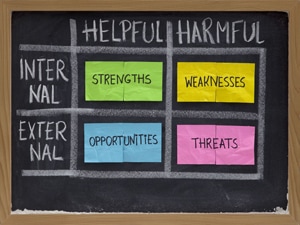 Knowledge is key to running a successful business, knowledge about your customers, your competitors, your own operation and the wider business environment. A SWOT analysis will help you gather the information you need to make a full and thorough assessment of your business and your market. A SWOT analysis is a simple but powerful tool for identifying the strengths and weaknesses of your operation and the opportunities and threats you face in your market. It will give you a clear picture of how well your business is running and the wider marketing and sales environment you are operating in. Business analysis - your strengths and weaknesses Identifying your companies strengths and weaknesses should be straightforward, particularly if you talk to a range of people when putting your SWOT analysis together. If you have employees, you'll find they have a good idea of what works and what doesn't. Customers, suppliers and other business partners can also give you feedback on your performance. Work through a list of the different elements of your operation. For example, finance, staffing, operations and marketing are key areas you can examine. Your SWOT analysis will be more useful if you look at your strengths and weaknesses in terms of what you are trying to achieve and if you compare yourself with your key competitors. Where do you have a competitive edge - or a problem? Market analysis - opportunities and threats You should also talk to employees, customers, suppliers and other business partners about the main opportunities and threats facing your business. Ask them about all the people and organisations that affect your business and how they are changing. Competitors, customers, suppliers and distributors will all have an impact on how successfully you trade. You should then assess the broader business environment and how it is changing using a PEST analysis:
A good PEST analysis can provide you with a strong foundation for an effective marketing strategy. Carrying out and using a SWOT analysis A brainstorm with employees may well be the best starting point for your SWOT analysis. You'll have to be open-minded and willing to accept some criticism of your business, but remember, the idea is to get a realistic view. Likewise, ask your customers for their honest feedback about your products and service standards. If you want to take a more formal approach to SWOT analysis, you could pay for professional help or get involved in a benchmarking study. Whichever approach you choose, however, your assessment must lead to an action plan. This should focus on how you exploit opportunities that play to your strengths and how you address weaknesses in your business in order to deal with threats that face you. Your marketing strategy should also aim to protect your business against threats. Building strong relationships with customers and making sure that your products and customer service stand out can be key elements of your defence against the competition.
0 Comments
Leave a Reply. |
AuthorLisa Hunter is an experienced Marketing, Events and Project Manager. She has over 10 years’ experience working in the IT and marketing industry, delivering strategic marketing support and managing creative projects for a wide-range of clients. In this blog she shares her knowledge and experiences…we hope you enjoy it. Archives
June 2019
Categories
All
|
 RSS Feed
RSS Feed